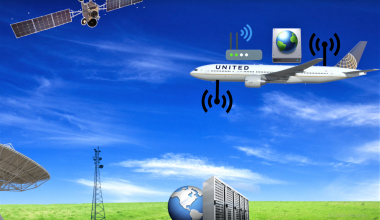Airbus and Boeing are indeed the world’s prominent aircraft manufacturers with the highest selling rate, which dominate the aerospace industry compared to other aircraft manufacturers. In terms of foundation date, Boeing is older than Airbus. Boeing is a part of the US, while Airbus lies to European countries. Both companies have their very own logo, and their logos have a pleasant history.
Boeing logo history
The Boeing Corporation is a world-renowned American aerospace and defense corporation, also abbreviated as Boeing. Boeing is a commercial passenger jet and military aircraft manufacturer, and one of the world’s leading aerospace companies. The company was founded by an American entrepreneur named William E. Boeing in Seattle in 1916.
The initial Boeing logo from the company was designed in the 1920s and consisted of three distinct badges. The first was a detailed picture of the bird flying to the east, with an arrow above it, where the wordmark symbolized for momentum and independence. The second badge featured two stylized wings, bent up, with two loops in the center. It appeared as if it was a luxury car badge symbolizing quality and elegance. Boeing’s third emblem consisted of a wordmark with two white wings in a black outline, scattered from the center to both sides. It was a stylish Boeing logo that completely embodied the company’s mission and profile.

The concept of 1939 brought a new form and appearance to the external identity of the aircraft manufacturer. With the letter “G” expanded, a talisman was constructed around a vertically placed word label, forming a pedestal with two wings at its tip. It was a beautiful and impressive emblem that soon became familiar and stuck with the organization for another ten years.
In 1940, a completely different understanding of brand style was launched. The logotype was rendered in a script typeface and positioned diagonally, the star replacing the point above the letter “I.” It was a tremendous and often elegant symbol that represented style and design development, movement, and quality. The inscription became an intrinsic part of its visual identity and remained a strong and important one.
In 1947, two Boeing designers, Kith Kinsmen, and Bob Laly, set out to create a long-term, permanent logo. They introduced a logo proposal of 10 pages consisting of reflectivity, appearance, and textures. Later in the same year, the totem-based logo was changed to a simple new logo with the word ‘Boeing.’ This logo used the stratotype font. Throughout the following decades until the 1990s, the design was used in combination with plane model numbers and was numerously updated and redrawn.
[the_ad id=”28989″]In 1997 Boeing merged with McDonnell Douglas Corporation, and the logo revamped, incorporating the brand logos of both companies. The strong logotype adopts an attractive and distinctive symbol, a circle with a stylized wing and a ring around it on its right. The new logo was presented in a blue and gray scheme, where the blue was used for the lettering and the grey for the icon; the color combination ideally represents the organization’s purpose and design, symbolizing air, speed, and defense. Using the Boeing logo with a bright blue hue represents the sky and the dominance, power, and success.
Present Boeing Logo and Fonts
The latest logo belongs to famed American graphic designer Rick Eiber. The Boeing logo now incorporates the sphere with the company’s name, written in the new Stratotype typeface. To symbolize the sky, the letters are lit in light blue. The emblem itself reflects the organization’s ambition to achieve higher heights, success, and a promising future.
The classic logo is displayed in all capital letters in a modified sans-serif form, which is presumably based on the Tipemite Oblique or House Sans Italic Heavy fonts. The inscription is healthy and preferably balanced, representing courage and free spirit and evoking a sense of trustworthiness, confidence, and peace.
Airbus logo History
The Airbus logo belongs to Airbus SAS, which is also known by the simple name of Airbus, a European aerospace company. It was founded in Toulouse, France, as a Streamlined SPA in 2001. Previously, it was a company called Airbus Industry, not necessarily participating in the production phase of the aircraft, but merely to manage the design and sales process. The name “Airbus” was derived from the word used by aircraft manufacturers in the 1960s to create a specific size and range commercial aircraft since the word was linguistically acceptable to French.

During the past two decades, the Airbus logo has undergone two changes. Although the improvements have been very significant, it is fair to assume that each new concept has based on its predecessor.
The 2001 Airbus logo was the circular split into two equal parts. — of the halves has a dynamic abstract pattern, inspired by curves, whirls, and swooshes. At symbolic level, the logo can be viewed as the Globe (the circle) and the airlines as the shortest way to get from one location to another (the complex curves). The fact that the letters are italic font adds more versatility to it.
The previous logo’s roundel segment had a 3D effect later in 2010, owing to the gradient’s inclusion to the backdrop. The term ‘Airbus’ is different. While it is still a sans, it has not italicized now and has a few distinctive details the “A” and “R” gaps, for example. Even the lettering has a 3D look due to the gradient applied. However, in 2017, the revised Airbus logo was smooth and did not feature just the word label on the whirling symbol. The dark hue of blue, somewhat black, stayed much the same.
Airbus logo Symbol and Color
The Airbus symbol consists of a white circle within which has blue lines. It shows that, due to the ambition, creativity, and people of the company, Airbus aircraft have made independence possible in the last 40 years. The Airbus logo hue is sky-blue. That is a hue of blue. It demonstrates sea and sky colors, a symbol of height and distance. Blue evokes color, warmth, freshness, and tranquility. It symbolizes pureness and constancy.





